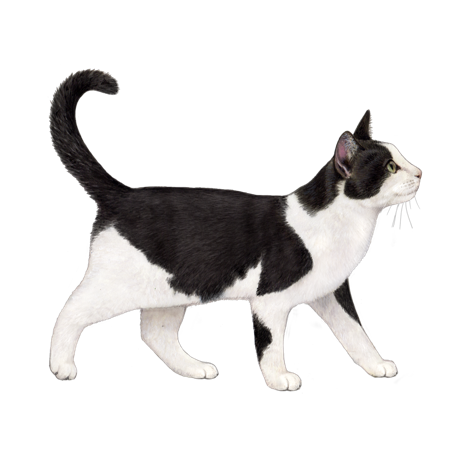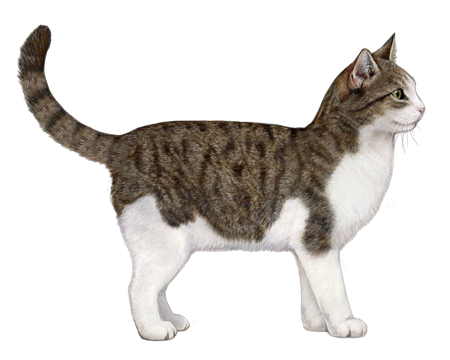
Ragdoll
Ragdolls are large, easy-going cats with affectionate personalities. They love to play and are happy to flop over in their human's arms for a cuddle session when it's time for a break.
Interested in discovering if your cat is a Ragdoll?
Check out Wisdom Panel's DNA test.
Ragdoll Traits
General Appearance
Ragdolls are large, semi-longhaired cats with blue eyes. They have strong, muscular bodies but are slow to mature and may not reach their full size and coat color until they're about four years old.
Coat and Colouring
The Ragdoll has an abundant, silky topcoat and minimal undercoat. The cat's hair grows short on the face and increases in length as it moves down the back. Long hair surrounds the breed's neck and frames the outside of the face, forming a bib. The hair on the belly, side, and back legs is medium length, while the hair on the front legs is short-to-medium. The tail is fully feathered.
Ragdolls are pointed cats, which means they have darker colors on the face, legs, tail, and ears. They come in seal, blue, chocolate, lilac, red, cream, cinnamon, or fawn, and can have tortie or tabby markings. Their color pattern can be colorpoint (dark points with no white and a strong contrast between light body color and point color), mitted (pointed with white paws, a white chin, and a white belly stripe), or bicolor (white chest, legs, stomach, and ruff with an inverted white "V" on the face).
Distinctive Physical Traits
One of the trademark traits of the Ragdoll is large, oval-shaped, strikingly blue eyes. Other physical characteristics include medium-sized ears with rounded tips, a long, rectangular-shaped body, round, tufted paws, and a long, bushy tail.
Ragdoll Temperament
Ragdolls are loving, relaxed, family-friendly cats. They enjoy being around people and often greet their humans at the door and follow them from room to room. Their trademark way of showing trust and affection is to flop limply in their owner's arms when cuddled.
This breed is very tolerant of other pets and kids. Because they are so laid back and quiet, Ragdolls aren't likely to be a good fit for someone looking for an active, energetic cat. They aren't overly athletic (and can sometimes be downright clumsy). So, short cat trees and an indoor lifestyle help keep these felines safe from injury.
Though Ragdolls are very easy-going and calm, they still enjoy short playing sessions and can even learn to fetch. This skill—along with their general intelligence and happy disposition—has earned them a reputation as a "dog-like" cat.
Ragdoll History
The Ragdoll breed got its start in Riverside, CA, in the 1960s. Eccentric breeder Ann Baker mated a longhaired white cat named Josephine with other cats she owned or found in the neighborhood. These likely included a seal point mitted cat and a solid black cat.
Baker maintained that injuries from a car accident altered Josephine's genes—and that's why subsequent litters of her kittens had the floppy, laid-back personality associated with Ragdolls today. Though Baker's explanation isn't biologically possible, it does make a great story!
Several breeders contracted as a franchise under Baker's breeding program (and under her watchful eye). Eventually, they branched out on their own to continue developing the breed standard.
Today, Ragdolls are a popular breed thanks to their happy, relaxed dispositions and striking good looks.
Ragdoll Care
Nutrition
Ragdolls need a high-quality diet. Because nutritional needs vary for kittens, adults, and senior cats, take care to choose a formula that's age-appropriate for your pet. You might also consider diets designed for the Ragdoll's unique needs. For example, a breed-specific diet may include nutrients that help keep their coats shiny or bones and joints healthy—two key concerns for Ragdolls.
All cats can become overweight if they eat too many calories. But because of their large size, a few extra pounds can be especially taxing on Ragdolls' joints. To avoid overfeeding, carefully measure out your cat's food with a standard measuring cup and reduce portions if they gain weight. And keep an eye on the number of treats you're feeding. As a guideline, treats should make up no more than 10% of a cat's daily calories.
In addition to daily meals, make sure there's a bowl of fresh, clean water available at all times. Your Ragdoll may enjoy drinking out of water fountains.
Grooming
To keep your Ragdoll's silky coat looking its best, brush weekly with a stainless steel comb. Your cat may require extra grooming sessions during seasonal shedding periods. However, their minimal undercoat means reduced shedding and matting compared to other longhaired breeds.
In addition to regular brushing, trim your cat's nails once a month to keep them at an appropriate length. Nails that get too long are more likely to snag on something and become torn or damaged. Overgrown nails can also grow into your cat's paw pads, leading to pain or infection. Besides clipping, providing a scratching post will help keep their nails in good shape and satisfy their instinct to scratch.
Dental care is also essential to their overall health. Do your best to brush your cat's teeth at home, and don't forget to schedule professional exams and dental cleanings with your veterinarian.
Health
The Ragdoll's large size makes them more prone to issues with their bones or joints. Keeping your cat at a healthy weight will help prevent them from taxing their joints with unnecessary pounds. You can also talk to your veterinarian about supplements that may improve bone or joint health.
Ragdoll Genetic Health Conditions
-
Factor XII Deficiency (Variant 1)
Factor XII Deficiency, also known as Hageman trait, is an asymptomatic blood factor deficiency. While it does not cause an abnormal tendency to bleed, it can be observed as prolonged blood clotting times during certain laboratory screening tests.
-
Factor XII Deficiency (Variant 2)
Factor XII Deficiency, also known as Hageman trait, is an asymptomatic blood factor deficiency. While it does not cause an abnormal tendency to bleed, it can be observed as prolonged blood clotting times during certain laboratory screening tests.
-
Hypertrophic Cardiomyopathy (Discovered in the Ragdoll)
Hypertrophic Cardiomyopathy (Discovered in the Ragdoll) is a disorder where the heart muscle wall increases in thickness, eventually leading to heart failure.
-
MDR1 Medication Sensitivity
MDR1 Medication Sensitivity is a disorder caused by a defect to a drug pumping protein that plays an important role in limiting drug absorption and distribution (particularly to the brain). Cats with the MDR1 variant may have severe adverse reactions to some commonly used medications.
-
Polycystic Kidney Disease (PKD)
Polycystic Kidney Disease (PKD) is the most common inherited disease in cats. The disease causes the formation of fluid-filled cysts in the kidneys that can lead to kidney failure.
With more than 45 health tests, Wisdom Panel™ Complete for Cats screens for these and other important genetic conditions—allowing you to better plan for your cat's lifelong care.
Breed Group
Western
The largest of breed groups, the Western Group is mainly comprised of cats developed in Europe and the Americas. Due to the complexity of feline genetic diversity, however, cat breeds from other regions may also be found associated with this group.


























